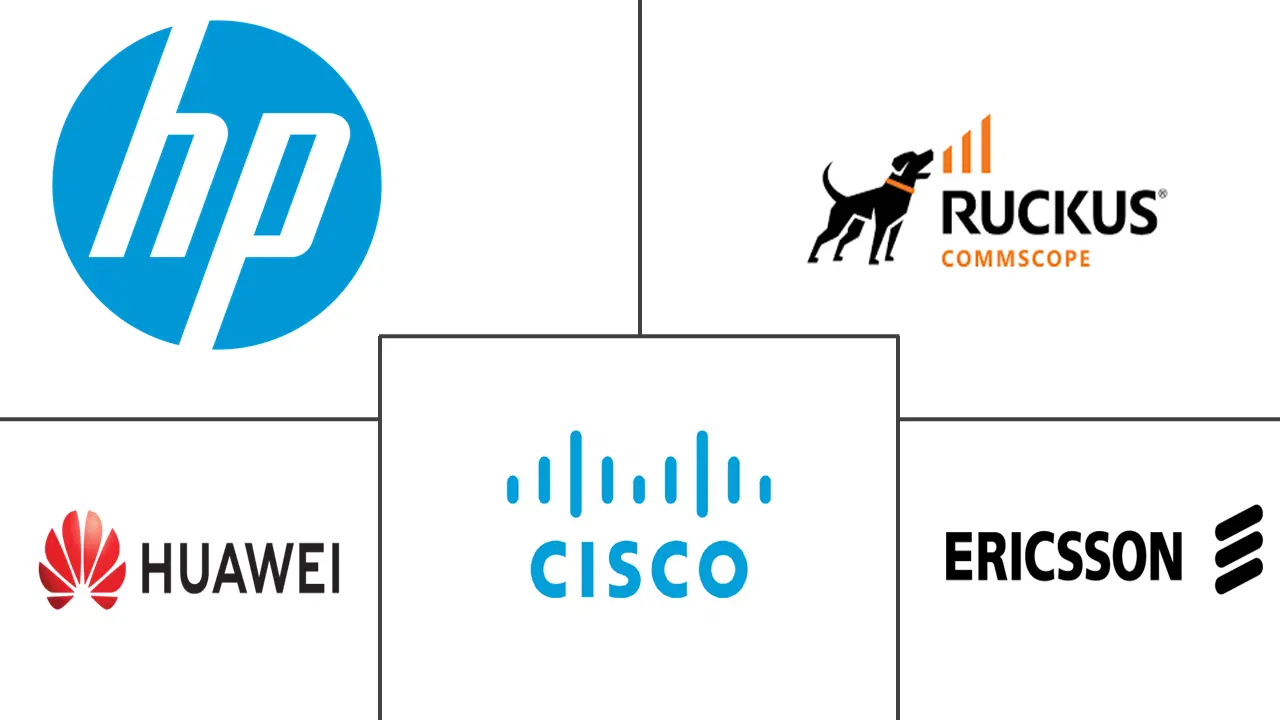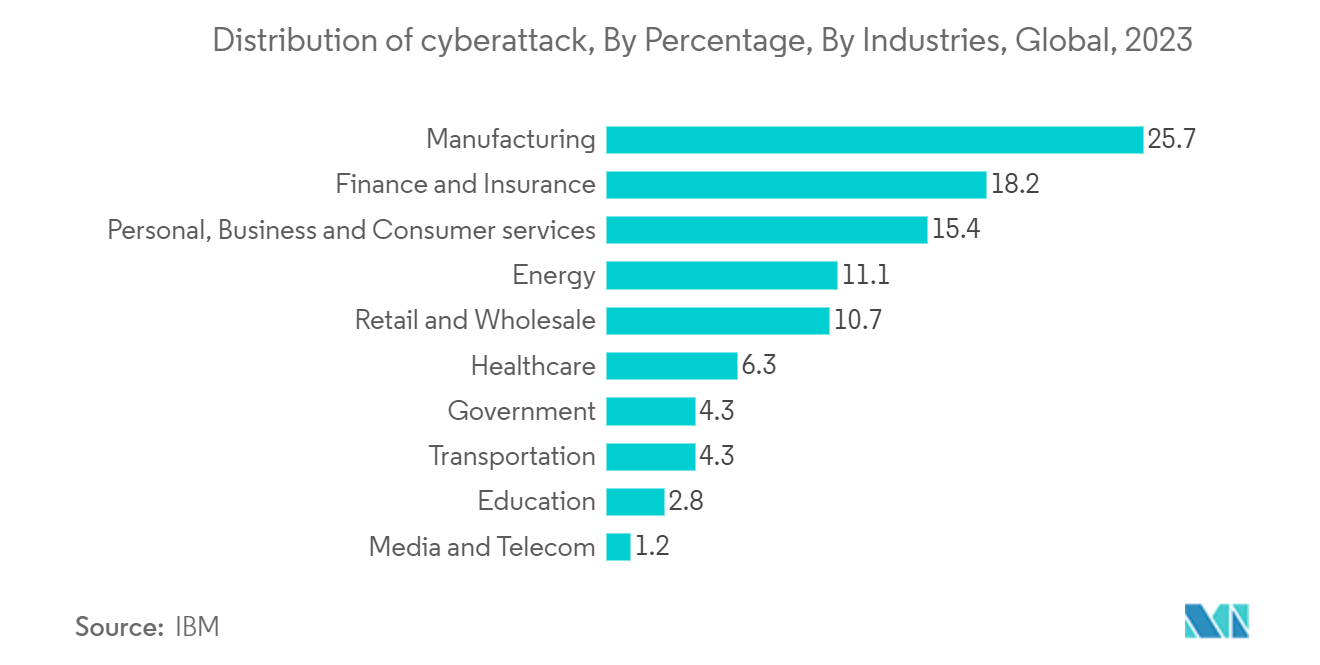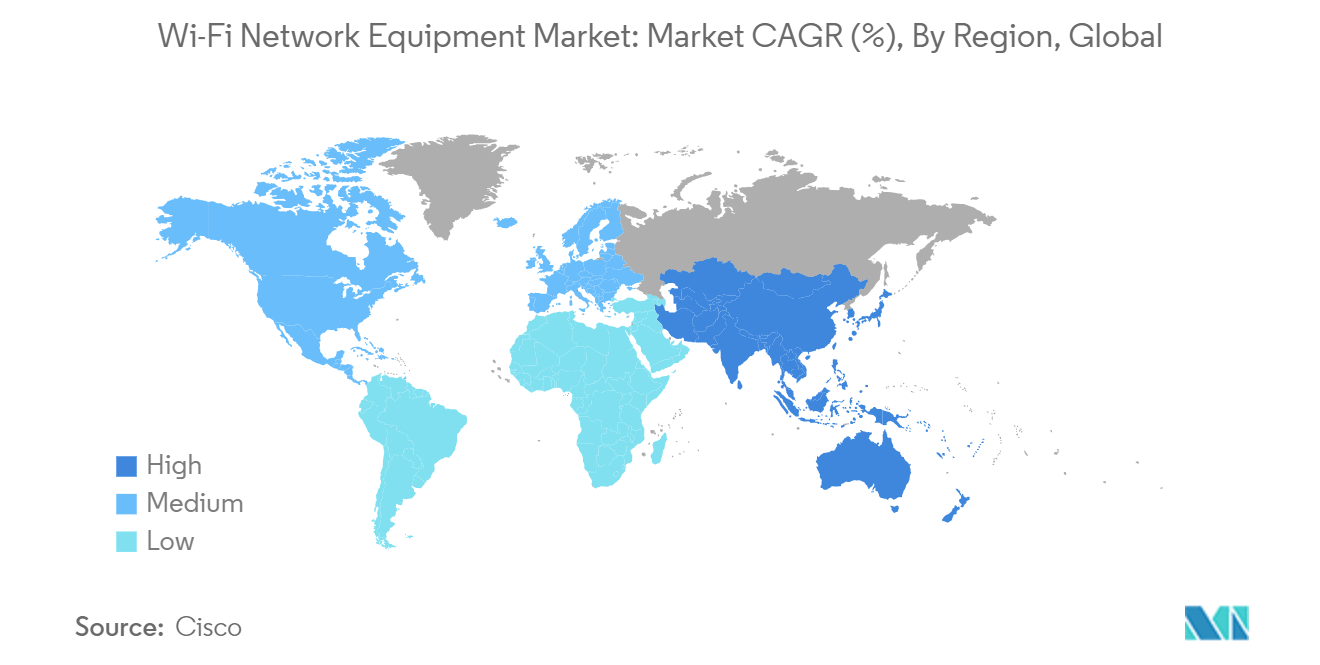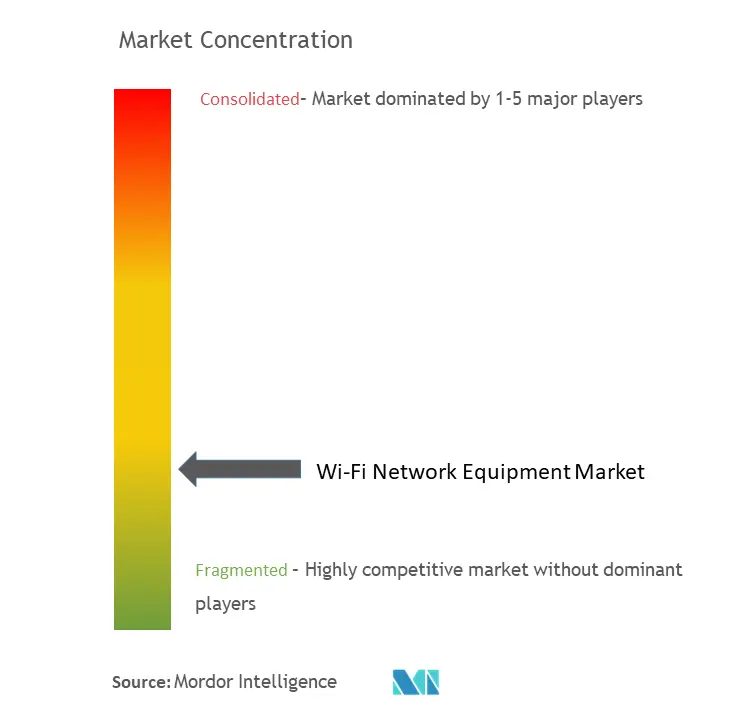Wi-Fi Network Equipment Market Size

| Study Period | 2019 - 2029 |
| Market Size (2024) | USD 1.85 Billion |
| Market Size (2029) | USD 3.17 Billion |
| CAGR (2024 - 2029) | 11.35 % |
| Fastest Growing Market | Asia Pacific |
| Largest Market | North America |
Major Players
*Disclaimer: Major Players sorted in no particular order |
Wi-Fi Network Equipment Market Analysis
The Wi-Fi Network Equipment Market size is estimated at USD 1.85 billion in 2024, and is expected to reach USD 3.17 billion by 2029, growing at a CAGR of 11.35% during the forecast period (2024-2029).
- The increasing use of Internet of Things (IoT) devices in consumer, commercial, and industrial settings is a key driver for equipment demand. With the rise of 5G technology, organizations are poised to embrace even more connected devices, enhancing their ability to leverage business data. This surge in smart and connected device adoption directly fuels the global Wi-Fi network devices market's growth.
- Furthermore, many enterprises are overhauling their network equipment to bolster security and streamline data exchanges. The adoption of the latest Wi-Fi standards, Wi-Fi 6 and Wi-Fi 6E connectivity, facilitates improved speed, capacity, and efficiency in handling multiple devices simultaneously. These advancements are crucial for supporting bandwidth-intensive applications such as video conferencing, gaming, and IoT devices. As per the 'World in Data,' only 63% of the population had access to the online internet in 2023, which provides immense growth potential.
- While return-to-office mandates gained traction in 2023, the call for flexibility remains strong. Many firms view office returns as pivotal for bolstering their culture, yet the shift back poses significant hurdles. Collaboration provides traditional office setups, including in-person meetings, virtual calls, and advanced technology. Thus, there is still growth in the requirement for home Wi-Fi devices to cater to the demand.
- Wi-Fi networks encounter a myriad of security threats, primarily stemming from the prevalence of Wi-Fi-enabled devices. Despite technological advancements in security protocols, maintaining data safety and integrity remains a significant challenge. Particularly in corporate settings, when handling sensitive information, the risk of data breaches increases. Attackers exploit these vulnerabilities, often resulting in unauthorized data access.
- After the COVID-19 pandemic, enterprise and service providers invested heavily in upgrading the network infrastructure to cater to the increasing load that is coming from the remote user. The company planned for upgrading the existing Wi-Fi networks and implementing new technologies to ensure secure and reliable connectivity.
Wi-Fi Network Equipment Market Trends
The Enterprises Segment is Expected to Hold a Major Share
- Enterprises form a pivotal segment, offering the infrastructure and services crucial for organizational, educational, healthcare, and large-scale business communication. They oversee the deployment and maintenance of network infrastructures, supporting voice, data, and internet services.
- Public safety entities, including police, fire, and emergency services, heavily depend on these Wi-Fi network equipment devices for swift information sharing, coordination, and emergency response. Moreover, the healthcare sector relies on these networks for secure patient data transmission, telemedicine, remote monitoring, and seamless medical data exchange among professionals.
- Moreover, there is a growing need for Wi-Fi 6 (802.11 ax) adoption, which is driven by higher speed and better performance in dense environments. Many enterprises are upgrading to Wi-Fi 6, which caters to the increasing need for bandwidth-intensive applications. Many enterprises are moving toward cloud-managed Wi-Fi solutions, which allow centralized management, scalability, and easier deployment.
- AI platforms and applications empower enterprise developers, enabling them to harness ML's capabilities for heightened accuracy, user experience, and efficiency. The reach of AI is set to span from the edge to the core to the cloud. For instance, in December 2023, Origin AI and Airties joined forces to enhance ISP revenue and customer satisfaction through Wi-Fi Sensing Technology. This collaboration marks a significant advancement in Smart Wi-Fi solutions. By leveraging the partnership, Airties’ ISP clients included an advanced intrusion detection feature in their broadband offerings. By integrating Origin’s advanced technology, Airties aims to not only boost ISPs' revenue streams but also combat customer churn and elevate their Net Promoter Scores (NPS).
- Moreover, increasing cybersecurity threats encourage enterprises to use advanced Wi-Fi solutions with better security features to protect data and remain compliant with country-specific regulations. As per data by IBM, the manufacturing sector was exposed to maximum cyber threats, which were 25.7%, followed by the finance and insurance sector, with 18.2% threats in 2023.

Asia-Pacific is Expected to Hold a Major Growth Share
- 5G and Wi-Fi are often seen as complementary technologies. While 5G primarily provides broad network coverage and high-speed mobile connectivity, Wi-Fi offers high-capacity and localized coverage, especially indoors. Several advanced markets have taken the lead in rolling out 5G in Asia-Pacific. South Korea set the global pace by launching the world's first nationwide 5G network in April 2019. This was swiftly followed by similar deployments in Australia, the Philippines, China, and New Zealand later that same year. According to GSMA Intelligence, the region is now witnessing a second wave of 5G rollouts, with countries like Indonesia, India, and Malaysia poised to propel Asia-Pacific into one of the world's largest 5G markets by 2025.
- There is growing investment in expanding public Wi-Fi infrastructure to provide reliable internet access in urban areas, public transportation, and venues. This trend is supported by government initiatives and private-sector investments that aim to improve connectivity for all. According to Cisco, Asia-Pacific is expected to have the highest share of global public Wi-Fi hotspots, at around more than 48% in 2024.
- AI and machine learning are increasingly shaping network management and automation. These technologies automate network settings, streamline issue resolution, and enhance performance based on usage patterns. AI plays a pivotal role in optimizing energy consumption within network infrastructures, leading to substantial reductions in both carbon footprints and operational costs, especially in advanced telecommunications networks. According to the CompTIA IT Industry Outlook 2024 survey, 30% of channel firms are already integrating AI into their operations, while an additional 26% are actively exploring AI solutions.
- As digital files, including high-definition videos, software updates, and datasets, continue growing, networks with high speeds and greater bandwidth are crucial. They enable faster transfer rates and empower users to download and upload files swiftly online. Many corporations are now gravitating toward cloud databases for enhanced data protection. In this landscape, Wi-Fi with expanded bandwidth emerges as a key player, facilitating swift and efficient access to online data.
- High-bandwidth speeds are becoming imperative, especially as consumer cloud storage gains traction, ensuring that downloading large multimedia files is as swift as transferring them from a local hard drive. For example, a Cisco report highlights that Asia-Pacific has achieved a remarkable 97% penetration rate in delivering speeds exceeding 25 Mbps.
- Several market players are enhancing Wi-Fi technologies to cater to advanced solutions for augmented reality use cases. In February 2024, Huawei set the tone by introducing its enterprise-grade "AirEngine Wi-Fi 7," a cutting-edge solution that adheres to the latest Wi-Fi standards. This technology promises a more robust and seamless wireless network, especially in scenarios demanding high-density, high-bandwidth, and low-latency connections. These scenarios include accessing the metaverse and leveraging augmented reality/virtual reality (AR/VR) for educational purposes.

Wi-Fi Network Equipment Industry Overview
The Wi-Fi network equipment market is fragmented, with various significant players. In the market, numerous vendors are focused toward diverse growth strategies such as collaborations, partnerships, and new launches. Notable players include Cisco Systems Inc., Hewlett Packard Enterprise Development LP (Aruba), CommScope (RUCKUS Networks), Telefonaktiebolaget LM Ericsson, and Huawei Technologies Co. Ltd.
- In January 2024, CommScope, a prominent player in network connectivity, revealed that the Wi-Fi Alliance had chosen a member of its RUCKUS Wi-Fi 7 AP family for rigorous testing. This selection places the RUCKUS device as the sole commercial access point in the certification test bed, ensuring seamless interoperability with Wi-Fi CERTIFIED 7 devices. This move underscores CommScope's commitment to advancing Wi-Fi performance for the global network of next-gen devices.
- In November 2023, At Huawei Connect 2023, Huawei unveiled its All-Scenario WLAN Solution. This launch further focused on the adoption of Wi-Fi 7 technology in the enterprise sector, enhancing network experiences for customers across industries like education, healthcare, retail, and manufacturing. With the deployment of Wi-Fi 7's enhanced bandwidth capabilities, campus networks are gearing up for a multi-Ge campus evolution to handle the increased traffic.
Wi-Fi Network Equipment Market Leaders
-
Cisco Systems Inc.
-
Hewlett Packard Enterprise Development LP
-
Telefonaktiebolaget LM Ericsson
-
Huawei Technologies Co., Ltd.
-
CommScope (RUCKUS Networks)
*Disclaimer: Major Players sorted in no particular order

Wi-Fi Network Equipment Market News
- January 2024: Wi-Fi Alliance announced the launch of Wi-Fi CERTIFIED 7, with many new features designed to enhance Wi-Fi performance and connectivity in diverse settings. The advanced features of Wi-Fi CERTIFIED 7 prioritize high throughput, deterministic latency, and enhanced reliability, especially for crucial data streams. This latest Wi-Fi iteration is set to propel various applications, from multi-user AR/VR/XR and immersive 3-D training to electronic gaming, hybrid work setups, industrial IoT, and automotive advancements.
- January 2024: At CES 2024, Edgecore Networks, known for pioneering network solutions, and Morse Micro, a Wi-Fi HaLow silicon vendor, jointly introduced the Edgecore EAP112 Wi-Fi HaLow router. This router, named the EAP112, is a Wi-Fi 6 2×2 Matter gateway, boasting support for both HaLow (802.11ah) and 4G LTE. By leveraging 4G LTE for connectivity, the EAP112 offers Wi-Fi 6 services, with a specialized focus on long-range IoT applications through its HaLow feature.
Wi-Fi Network Equipment Market Report - Table of Contents
1. INTRODUCTION
- 1.1 Study Assumptions and Market Definition
- 1.2 Scope of the Study
2. RESEARCH METHODOLOGY
3. EXECUTIVE SUMMARY
4. MARKET INSIGHTS
- 4.1 Market Overview
- 4.2 Analysis of Macro-Economic Scenarios (Recession, Russia-Ukraine crisis, etc.)
-
4.3 Regulatory Landscape Related to Internet Services
- 4.3.1 Coverage on Data protection Guidelines in Various Countries
5. MARKET DYNAMICS
-
5.1 Market Drivers
- 5.1.1 Growth in the use of connected devices and BYOD policy
- 5.1.2 Rising Digital Transformation in the Enterprises
- 5.1.3 Ongoing Technological Advancements in Wi-Fi Technology (Wi-Fi 6 Standard Implementation, etc.)
-
5.2 Market Restraints
- 5.2.1 Data securities and Privacy Concerns
- 5.2.2 Concerns Related to Wi-Fi Implementation in Outdoor Areas
-
5.3 Insights on Wi-Fi connectivity standards
- 5.3.1 Coverage on 802.11b, 802.11a, 802.11g, 802.11n, 802.11ac, and 802.11ax
- 5.4 Case Study Analysis
-
5.5 Overview of Adoption Trends of Guest Enterprise Wi-Fi Offerings
- 5.5.1 Growth Drivers (Increasing Need for Customer Engagement and Loyalty| Growing Trends of BYOD in Enterprises | Need for Enhanced Cyber Security Measures for Enterprises Assets with Reliable Wi-Fi Access)
- 5.5.2 Overview of Enterprise Wi-Fi Hotspot Management Solution and Key Features (Including Analytics)
- 5.5.3 Industry-wise use cases
- 5.5.3.1 Coverage on Travel and Hospitality, IT and telecom, Retail and E-commerce, Education, BFSI, etc.
- 5.5.4 Brief About Major Vendors and Their Offerings
- 5.5.4.1 Coverage on Purple WiFi, Noniussoft, AVSystem, Wanaport, etc.
6. MARKET SEGMENTATION
-
6.1 By Equipment Type
- 6.1.1 Access Points
- 6.1.2 Gateways
- 6.1.3 Routers and Extenders
- 6.1.4 Others (Cables, Interface, Modules, etc.)
-
6.2 By End User
- 6.2.1 Consumers
- 6.2.2 Enterprises
-
6.3 By Geography***
- 6.3.1 North America
- 6.3.1.1 United States
- 6.3.1.2 Canada
- 6.3.2 Europe
- 6.3.2.1 United Kingdom
- 6.3.2.2 Germany
- 6.3.2.3 France
- 6.3.3 Asia-Pacific
- 6.3.3.1 China
- 6.3.3.2 India
- 6.3.3.3 Japan
- 6.3.4 Australia and New Zealand
- 6.3.5 Middle East and Africa
- 6.3.5.1 Saudi Arabia
- 6.3.5.2 United Arab Emirates
- 6.3.5.3 South Africa
- 6.3.6 Latin America
- 6.3.6.1 Brazil
- 6.3.6.2 Mexico
7. COMPETITIVE LANDSCAPE
-
7.1 Company Profiles*
- 7.1.1 Cisco Systems Inc.
- 7.1.2 Hewlett Packard Enterprise Development LP (Aruba)
- 7.1.3 CommScope (RUCKUS Networks)
- 7.1.4 Telefonaktiebolaget LM Ericsson
- 7.1.5 Huawei Technologies Co. Ltd
- 7.1.6 Extreme Networks
- 7.1.7 Ubiquiti Inc.
- 7.1.8 D-Link Corporation
- 7.1.9 TP-Link Corporation
- 7.1.10 NETGEAR Inc.
8. MARKET OPPORTUNITIES AND FUTURE TRENDS
** Subject To AvailablityWi-Fi Network Equipment Industry Segmentation
The Wi-Fi network equipment market study tracks the overall revenue accrued through the sale of Wi-Fi devices and associated services provided by market vendors to all-sized enterprises across the world. Wi-Fi is a trademarked term that denotes Wi-Fi-certified WLAN-based connectivity products that enable communication for various devices over the internet. The study also covers insights into adoption trends of guest enterprise Wi-Fi offerings.
The Wi-Fi network equipment market is segmented by equipment/device type (access points, gateways, routers and extenders, and others (cables, interface, modules, etc.), end-user (consumers and enterprises), and geography (North America, Europe, Asia-Pacific, Middle East and Africa, and Latin America). It also covers country-specific market dynamics, use case analysis, and regulatory landscape. The market sizes and forecasts are provided in terms of value (USD) for all the above segments.
| By Equipment Type | Access Points | |
| Gateways | ||
| Routers and Extenders | ||
| Others (Cables, Interface, Modules, etc.) | ||
| By End User | Consumers | |
| Enterprises | ||
| By Geography*** | North America | United States |
| Canada | ||
| By Geography*** | Europe | United Kingdom |
| Germany | ||
| France | ||
| By Geography*** | Asia-Pacific | China |
| India | ||
| Japan | ||
| By Geography*** | Australia and New Zealand | |
| Middle East and Africa | Saudi Arabia | |
| United Arab Emirates | ||
| South Africa | ||
| Latin America | Brazil | |
| Mexico |
Wi-Fi Network Equipment Market Research FAQs
How big is the Wi-Fi Network Equipment Market?
The Wi-Fi Network Equipment Market size is expected to reach USD 1.85 billion in 2024 and grow at a CAGR of 11.35% to reach USD 3.17 billion by 2029.
What is the current Wi-Fi Network Equipment Market size?
In 2024, the Wi-Fi Network Equipment Market size is expected to reach USD 1.85 billion.
Who are the key players in Wi-Fi Network Equipment Market?
Cisco Systems Inc., Hewlett Packard Enterprise Development LP, Telefonaktiebolaget LM Ericsson, Huawei Technologies Co., Ltd. and CommScope (RUCKUS Networks) are the major companies operating in the Wi-Fi Network Equipment Market.
Which is the fastest growing region in Wi-Fi Network Equipment Market?
Asia Pacific is estimated to grow at the highest CAGR over the forecast period (2024-2029).
Which region has the biggest share in Wi-Fi Network Equipment Market?
In 2024, the North America accounts for the largest market share in Wi-Fi Network Equipment Market.
What years does this Wi-Fi Network Equipment Market cover, and what was the market size in 2023?
In 2023, the Wi-Fi Network Equipment Market size was estimated at USD 1.64 billion. The report covers the Wi-Fi Network Equipment Market historical market size for years: 2019, 2020, 2021, 2022 and 2023. The report also forecasts the Wi-Fi Network Equipment Market size for years: 2024, 2025, 2026, 2027, 2028 and 2029.
Wi-Fi Network Equipment Industry Report
Statistics for the 2024 Wi-Fi Network Equipment market share, size and revenue growth rate, created by Mordor Intelligence™ Industry Reports. Wi-Fi Network Equipment analysis includes a market forecast outlook for 2024 to (2024to2029 and historical overview. Get a sample of this industry analysis as a free report PDF download.



